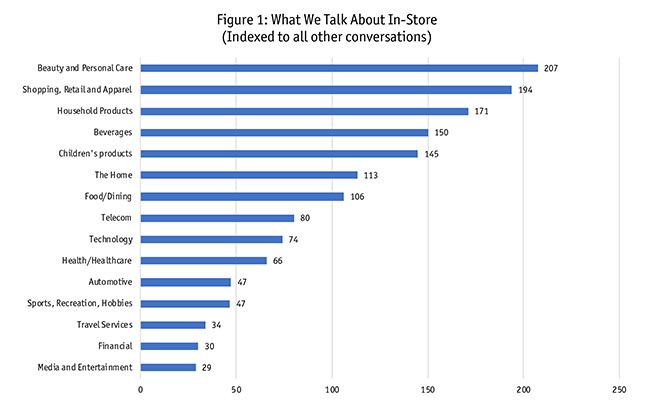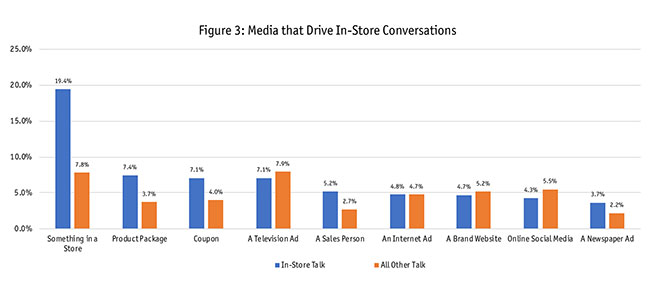Help them do it for the Gram
Editor's note: Ed Keller is the chief executive officer at Engagement Labs, a data and analytics firm. Brad Fay is the senior consultant at Engagement Labs.
 When marketers today hear the word “social” or ponder what it takes to be a social brand, they usually think about online media platforms such as Facebook, Twitter, Instagram and Snapchat. But America’s physical, brick-and-mortar retail stores are extremely social places, too, and provide marketers with myriad social marketing opportunities.
When marketers today hear the word “social” or ponder what it takes to be a social brand, they usually think about online media platforms such as Facebook, Twitter, Instagram and Snapchat. But America’s physical, brick-and-mortar retail stores are extremely social places, too, and provide marketers with myriad social marketing opportunities.
According to data from Engagement Labs, nearly 900 million times every week somebody in America is in a conversation about brands while in a store. That’s more than three times per week for every American adult and these in-store conversations can be pivotal in helping consumers decide which brand they pull off retail shelves, given their proximity to the actual purchase decision. While private homes are the overwhelmingly dominant location of consumer conversations, at 69 percent of the total, over 6 percent of all such conversations happen in stores, nearly as many conversations that happen at work (8 percent).
Our firm’s TotalSocial platform has been measuring online and offline consumer conversations and their impact on business for more than a decade. Three quarters of in-store conversations happen face-to-face, whether with a shopping companion, a store employee or stranger. One in five happen over the phone (13 percent) or via text message (7 percent), perhaps reflecting a “phone-a-friend” instinct when faced with a tricky choice in a shopping aisle. Another 4 percent happen by social media or e-mail. Face-to-face conversations are more prevalent among women, while men are more apt to use social media and e-mail while in store.
Our analytics, published in the MIT Sloan Management Review, show that 19 percent of all consumer purchases are driven by brand conversations, with the greatest impact in the two weeks prior to purchase. Half of this impact comes from offline conversations and half from online discussions in social media. Given the physical proximity of real-world, in-store conversations to purchase decisions, they are especially valuable to marketers.
(TotalSocial incorporates online and offline conversation data on more than 500 U.S. brands. For the analysis presented here, we analyzed data for 12 months ending February 2019. Offline conversation data are collected through a continuous online survey among a representative sample of consumers ages 13 to 69 from whom we measure daily word-of-mouth conversations about brands across a range of categories. The platform also combines these data with social media conversations collected through keyword searches of Twitter, public Facebook posts, blogs, forums and consumer review sites.)

Of course, the value of in-store conversations is much greater for those categories that tend to be purchased in physical retail stores. Just four categories account for more than half of all in-store conversations: retail/apparel (17 percent), beverages (14 percent), food/dining (12 percent) and beauty (11 percent). When compared to all other conversations (Figure 1), beauty and apparel conversations are twice as prevalent in-store versus in other locations. Household and children’s products also stand out as getting much more attention in-store rather than elsewhere.
Categories like technology, automotive, sports, travel and financial services get far less discussion in-store. Some of these – sports, media, travel, and financial – make sense given how and where purchases occur. But technology brands would probably like to be at the center of more conversations that happen in stores, since retail locations are an important way for people to become familiar with the latest and greatest products.
The brands that are most heavily represented in conversations at retail reflect the categories that perform best, with big emphasis on retailers themselves, apparel and footwear brands, beauty and various types of consumer packaged goods.
The following brands are three times more prevalent in conversations that occur in-store versus all other conversations: Nordstrom, TRESemmé, Foot Locker, V8 and Dial. More than 40 brands get at least double the conversation in-store, compared to other locations, which means brand managers for these brands – and their competitors – either are or should be designing shopper marketing to maximize the in-store “social” opportunity.
 One pattern that stands out is that Procter & Gamble owns the most brands with six among the 40 most “social” in-store brands (Table 1), reflecting the company’s long-time commitment to award-winning shopper marketing. The P&G brands punching above their weight in in-store conversations include Charmin, Crest, Febreze, Mr. Clean, Gillette and Old Spice.
One pattern that stands out is that Procter & Gamble owns the most brands with six among the 40 most “social” in-store brands (Table 1), reflecting the company’s long-time commitment to award-winning shopper marketing. The P&G brands punching above their weight in in-store conversations include Charmin, Crest, Febreze, Mr. Clean, Gillette and Old Spice.
As an example of P&G’s effective shopper marketing, the company won an Effie in 2017 for a program that featured a wide range of the company’s cleaning products, including Mr. Clean and Febreze, in Walgreens stores in “spring cleaning”-themed aisle endcaps.
Unilever is in second place, with four brands among the top 40 – TRESemmé, Dove Men + Care, Axe and Suave – while Johnson & Johnson has three brands and PepsiCo and Nestle each have two.
Influential consumers
One indicator of the value of in-store conversations is that they tend to occur among very influential consumers who have large social networks and regularly make recommendations. Influencers in the categories of food/dining, beverages, media/entertainment, technology and retail/apparel (Figure 2) are commonly found talking in stores about categories and brands, although that doesn’t mean these are the categories that come up in conversation while shopping. Based on our experience, a reason for influencers being prevalent in stores is it is the nature of influencers to be out and about, including at physical retail locations, and they are constantly seeking information including with people at retail settings.
 Because in-store conversations happen among influential people and close to purchase, marketers should be very motivated to drive more of them. But how to accomplish that at the critical “last mile” to purchase in brick-and-mortar stores?
Because in-store conversations happen among influential people and close to purchase, marketers should be very motivated to drive more of them. But how to accomplish that at the critical “last mile” to purchase in brick-and-mortar stores?
One obvious way is with in-store displays. About one in five in-store conversations (19.4 percent) relate to something they have seen in a store, more than any other marketing touchpoint and three times more frequently than in conversations happening elsewhere. Next most important are product packages themselves (7.4 percent) and coupons (7.1 percent).
When designing campaigns, how many marketers are thinking of their in-store displays, packages and coupons as fodder for consumer conversations? Not many, we believe, which means there could be significant opportunity for marketers to drive up these numbers with more talk-worthy messaging (Figure 3).
 Our advice to marketers seeking to improve their shopper marketing is to challenge their agencies and in-house teams to add a new objective: to drive discussion and advocacy at retail. Thinking about retail stores as social hubs is in line with the trend toward experiential shopping. As e-commerce takes a bigger bite out of commodity-type purchases, the physical retail experience should be both enjoyable and social.
Our advice to marketers seeking to improve their shopper marketing is to challenge their agencies and in-house teams to add a new objective: to drive discussion and advocacy at retail. Thinking about retail stores as social hubs is in line with the trend toward experiential shopping. As e-commerce takes a bigger bite out of commodity-type purchases, the physical retail experience should be both enjoyable and social.
Here are some specific ideas first for brand marketers:
- Consider investing more in retail displays. These have always been highly valued because of their proximity to purchase but their value is increased by their ability to stimulate discussion among influential consumers, too.
- Messaging at retail should be talkable, rather than primarily about price promotions. Craft your message with language likely to stimulate a discussion. Is your brand advertising coordinated with your shopper marketing to tell the same story? Extend your story in the aisle and complete the narrative of your marketing, not just to sell products.
- Encourage social media posts by making your display fun to photograph and share. How about a display that makes it Instagram-worthy?
- Find opportunities to stimulate conversations at checkout or point of sale among strangers in line through video.
- Use personalization when possible through digital targeting strategies such as personalized coupons or promotions redeemable in-store only.
And here are some ideas for retailers:
- Emphasize “shopping together” experiences. Provide coffee bars with seating and organize “singles” and “couples” shopping nights with special perks for participants. Is there an Instagrammable section at your store to make the experience shareable?
- Create and experiment with spaces at retail by creating community-driven spaces for customers. Why not launch a product sampling and demonstrations with full-blown performances and seating available?
- Use “attention shoppers” audio announcements to generate buzz. Invite the high school drama team to provide an in-store DJ who entertains and engages customers while bringing her friends.
- Train your staff to start conversations, especially about the products customers are buying. They can ask: “Have you tried this before? What did you like about it?” and fellow shoppers who may be listening may try and share too.
- Take some pointers from direct-to-consumer brands and use more digital elements to lure shoppers into the stores.
Tremendously social
Not every idea will be practical for all retailers and marketers but the point is shopping experiences are tremendously social and decisions about what to buy are being influenced by other people around us in the store. Indeed, the social experiences possible at retail could be one of the most important reasons for the relevance of bricks-and-mortar in the future.
